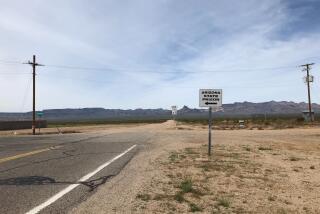Looters Raid Desert Grave of Mastodon
- Share via
GARDNERVILLE, Nev. — Time and archeological grave robbers are finally taking their toll on a prehistoric gem that has withstood millions of years of geologic upheaval.
Within a month of the chance discovery of the fossilized remains of a mastodon in late March and before excavation could begin, looters had moved in, taking some remains and damaging others.
Tom Lugaski, director of the W.M. Keck Museum at the University of Nevada at Reno, is optimistic that they left the best stuff behind.
“It’s like Christmastime with all these packages around here,” he said as the dig got underway at the end of April.
To his right, a pile of crushed ribs bore testimony to the work of vandals.
But to his left, about 20 scientists, students and volunteers picked and chipped around the partially exposed leg of the creature, which roamed what was then a marshy western Nevada 3 million to 3.5 million years ago.
The surprising find was made at the end of March by two teenagers who were riding motorcycles in the steep and rocky canyons of the Pine Nut Mountains.
The dig is on hold until workers remove dirt and rocks that the centuries have deposited in the rocky canyon uphill from the excavation.
The area has already yielded remains of camels, horses and extinct bears, which help establish the date of the American mastodon as being at the upper end of the species’ reign in North America. They first appeared about 3.75 million years ago and abruptly disappeared 10,000 years ago.
The age of this mastodon makes it a rare find but also makes radioactive carbon dating impossible, since that is accurate only to about 500,000 years, according to graduate student Tom Mantean.
More to Read
Sign up for Essential California
The most important California stories and recommendations in your inbox every morning.
You may occasionally receive promotional content from the Los Angeles Times.










